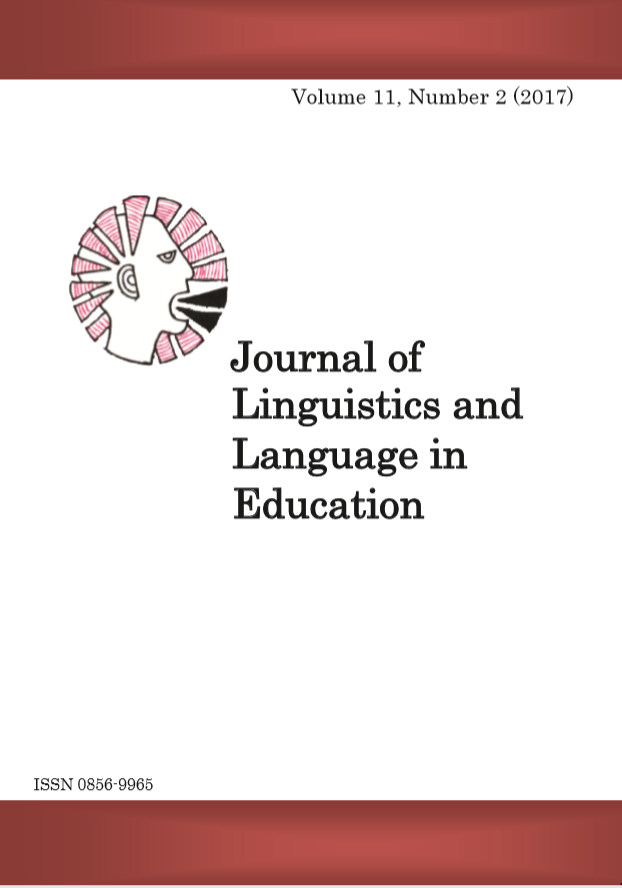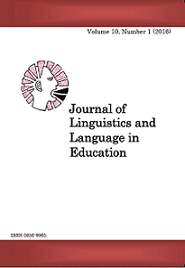The Linguistic Landscape of Muhimbili National Hospital in Tanzania: Its Implication for Access to Information
Abstract
The paper examines the nature of linguistic public signs that constitute what is popularly known as Linguistic Landscape (LL) at Muhimbili National Hospital (MNH) in Tanzania to explain their implication for access to information in the hospital. The study employed the sociolinguistic theoretical framework to examine the nature of the LL of MNH and its implication for access to information as presented through public signs at the hospital. Data for this study constituted photos/public signs from the hospital premises and interview narratives from hospital clients and staff. The data were analysed both quantitatively and qualitatively. Findings show that the LL of MNH is
more controlled by top-down than bottom-up actors in which there are three visible languages: English, Swahili, and Chinese. The most preferred language patterns do not guarantee access to information to hospital clients in the public space of the hospital, since some clients fail to understand what is communicated through the signboards placed in the public space of the hospital. They use unfamiliar language pattern(s), mostly in English. This lowers further their participation in promoting health and taking responsibilities of their health concerns
while at the hospital.
Key words: linguistic landscape, Muhimbili, public space, sign
References
Archibald, M. M. (2016). Investigator Triangulation: A Collaborative
Strategy with Potential for Mixed Methods Research. Journal of Mixed Methods Research, 10(3): 229 €“250.
Akindele, O. (2011). Linguistic Landscapes as Public Communication: A Study of Public Signage in Gaborone Botswana. International Journal of Linguistics, 3: 1 €“11.
Backhaus, P. (2005). Signs of Multilingualism in Tokyo: A linguistic
Landscape Approach. Unpublished PhD Thesis, University of
Duisburg-Essen, Tokyo.
__________ (2006), Multilingualism in Tokyo: A Look into the
Linguistic Landscape. International Journal of
Multilingualism, 3(1): 52 €“66.
__________ (2007). Linguistic Landscapes. A Comparative Study of
Urban Multilingualism in Tokyo. Clevedon €“Buffalo €“Toronto:
Multilingual Matters Ltd.
__________ (2008). The linguistic landscape of Tokyo. In M. Barni &
G. Extra (eds.). Mapping Linguistic Diversity in Multicultural
Contexts. Berlin: Mouton de Gruyter: 311 €“333.
__________ (2009). Rules and Regulations in Linguistic Landscaping:
A Comparative Perspective. In D. Gorter & E. Shohamy (eds.).
Linguistic Landscape: Expanding the Scenery. New York:
Routledge: 157 €“172.
Barni, M. & Bagna, C. (2010). Linguistic Landscape and Language
Vitality. In E. Shohamy, E. Ben-Rafael & M. Barni (eds.).
Linguistic Landscape in the City. Bristol: Multilingual Matters: 126 €“140.
Ben-Rafael, E., Shohamy, E., Amara, M. H & Trumper-Hecht, N.
(2006). Linguistic Landscape as Symbolic Construction of the
Public Space: The Case of Israel. International Journal of
Multilingualism, 3(1): 7 €“30.
Bever, O. A. (2010). Linguistic Landscapes of Post-soviet Ukraine:
Multilingualism and Language Policy in Outdoor Media and
Advertising. Unpublished PhD Dissertation. University of
Arizona.
Biswalo, T. (2010). Policy Processes in Relation to Language in
Tanzania: Examining Shifts in Language Policy. Unpublished
PhD Dissertation, University of Illinois.
Blackwood, R. & Tufi, S. (2012). Policies vs. Non-Policies: Analysing
Regional Languages and the National Standard in the
Linguistic Landscape of French and Italian Mediterranean
Cities. In Gorter, D., Marten, H. F. & Mensel, L. V. (eds.).Minority Languages in the Linguistic Landscape. London: Palgrave Macmillan: 109 €“126.
Blackwood, R. (2015). LL Explorations and Methodological
Challenges: Analysing France ' s Regional Languages.
Linguistic Landscape, 1(1/2):38 €“53.
Bwenge, C. (2009). Language Choice in Dar es Salaam ' s Billboards.
In F. McLaughlin (ed.). The Languages of Urban Africa. New
York: Continuum International Publishing Group: 152 €“177.
__________ (2012). Business Signs in Dar es Salaam: A
Sociolinguistic Perspective. Language in African Performing
and Visual Arts, 1: 48 €“59.
Coulmas, F. (2005). Sociolinguistics: The Study of Speakers ' Shoices .
Cambridge: Cambridge University Press.
Creswell, J. W. (2003). Research Design: Qualitative, Quantitative
and Mixed Methods Approaches (2nd ed.). London: Sage Publications.
Du Plessis, T. (2012). The Role of Language Policy in Linguistic
Landscape Changes in a Rural Area of the Free State Province of South Africa. Language Matters, 43(2): 263 €“282.
Garvin, R. T. (2011). Emotional Responses to the Linguistic
Landscape in Memphis, Tennessee: Visual Perceptions of Public Spaces in Transition. Unpublished PhD Thesis, Indiana University of Pennsylvania.
Gorter, D. (2006). Introduction: The Study of the Linguistic
Landscape as a New Approach to Multilingualism.
International Journal of Multilingualism, 3(1): 1 €“6.
_________ (2013), Linguistic Landscapes in a Multilingual World.
Annual Review of Applied Linguistics, 33:190 €“212.
Kamwendo, G. H. (2004).Language Policy in Health Services: A
Socio-linguistic Study of a Malawian Referral Hospital. Helsinki: Helsinki University Printing House.
Landry, R. & Bourhis, R. (1997), Linguistic Landscape and Ethnolinguistic Vitality: An Empirical Study. Journal of language and Social Psychology, 16(1): 23 €“49.
Languages of Tanzania Project (2009). Atlasi ya Lugha za Tanzania.
Dar es Salaam: Mradi wa Lugha za Tanzania, Chuo Kikuu
cha Dar es Salaam.
Legère, K. (2006). J. K. Nyerere of Tanzania and the Empowerment
of Swahili. In Martin, P., Joshua A. F. & JoAnne N. A. (eds.). Along the Routes to Power ' : Explorations of Empowerment through Language. Berlin. Mouton de Gruyter: 373 €“403.
________ (2007). Vidunda (G38) as an Endangered Language? In
Selected Proceedings of the 37th Annual Conference on
African Linguistics, 43 €“54.
Lewis, M. P. (ed.) (2009). Ethnologue: Languages of the World (6th ed.).
Maho, J. & Sands, B. (2003). The languages of Tanzania: A
Bibliography. Goteborg: Act Universitatis Gothoburgensis.
MartÃnez, G. A. (2014). Vital Signs: A Photo Voice Assessment of the
Linguistic Landscape in Spanish in Healthcare Facilities along the U.S-Mexico Border. The Journal of Communication and Health, 1: 1 €“21.
Mazrui, A. A. & Alamin, M. (1998). The Power of Babel: Language
and Governance in the African Experience. Oxford: James Currey.
Mkumbo, K. (2014, Machi). Kiingereza Tunakipenda lakini Hatutaki
Kujifunza. Raia Mwema.
Petzell, M. (2012). The Linguistic Situation in Tanzania. ModernasprÃ¥k, 1: 136 €“144.
Reh, M. (2004). Multilingual Writing: A Reader-oriented Typologywith
Examples from Lira Municipality (Uganda). International Journal of the Sociology of Language: 1 €“41.
Rubagumya, C. M. (1990). Language in Tanzania. In Rubagumya, C.
M. (ed.). Language in Education in Africa: A Tanzanian Perspective. Clevedon (UK): Multilingual Matters Inc: 57 €“83.
Saohatse, M. C. (2000). Solving Communication Problems in Medical
Institutions. South African Journal of African Languages, 20(1): 95 €“102.
Schuster, M. (2012). Language Accessibility of Signage in Public
Settings: A Case Study of a Healthcare Service. SALALS, 30(3): 311 €“324.
Schuster, M., Elroy, I. & Elmakais, I. (2016). We are Lost: Measuring
the Accessibility of Signage in Public General Hospitals. Lang Policy (2017), 16: 23 €“38.
Scollon, R. & Scollon, S. W. (2003). Discourses in Place: Language in
the Material World. London and New York: Routledge.
Shohamy, E. (2006). Language Policy: Hidden Agendas and New
Approaches. Routledge: London.
__________(2012). Linguistic Landscape and Multilingualism. In M.
Martin-Jones, A. Blackledge & A. Creese (eds.). The Routledge Handbook of Multilingualism. London: Routledge: 538 €“551.
__________ (2015). Linguistic Landscape Research as Expanding
Language and Language Policy. Linguistic Landscape, 1(1/2): 152 €“171.
Shohamy, E., Ben-Rafael, E. & Bam, M. (eds.) (2010). Linguistic
Landscape in the City. Bristol: Multilingual Matters.
Spolsky, B. (2004). Language Policy. Cambridge: Cambridge
University Press.
________ (2009). Prolegomena to a Socio-linguistic Theory of Public
Signage. In E. Shohamy & D. Gorter (eds.). Linguistic
Landscape: Expanding the Scenery. New York: Routledge: 25 €“
Spolsky, B. & Cooper, R. L. (1991). The Languages of Jerusalem.
Oxford: Oxford University Press.
Tibategeza, E. R. (2009). Language-in-Education Planning in
Tanzania: A Sociolinguistic Analysis. Unpublished PhD
Thesis, University of the Free State, Bloemfontein.
U.S. Department of Health and Human Services (2013). National
Standards for Culturally and Linguistically Appropriate
Service in Health and Health Care: A Blueprint for Advancing
and Sustaining CLAS Policy and Practice.
United Republic of Tanzania (1974). Government Secular No.1 on
Use of Swahili in Public Offices. Dar es Salaam: Government
Printer.
Downloads
Published
Issue
Section
License
Copyright © by Department of Foreign Languages and Linguistics, University of Dar es Salaam
All rights reserved. No part of this publication may be reproduced or transmitted in any form or by any means, electronic or mechanical, including photocopying, recording, or any information storage or retrieval system, without permission in writing from the publisher, except for short extracts in fair dealing, for research or private study, critical scholarly review or discourse with an acknowledgement.



